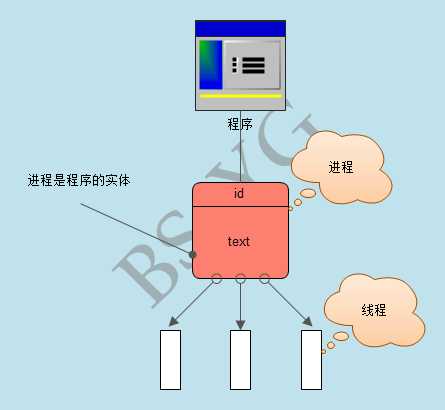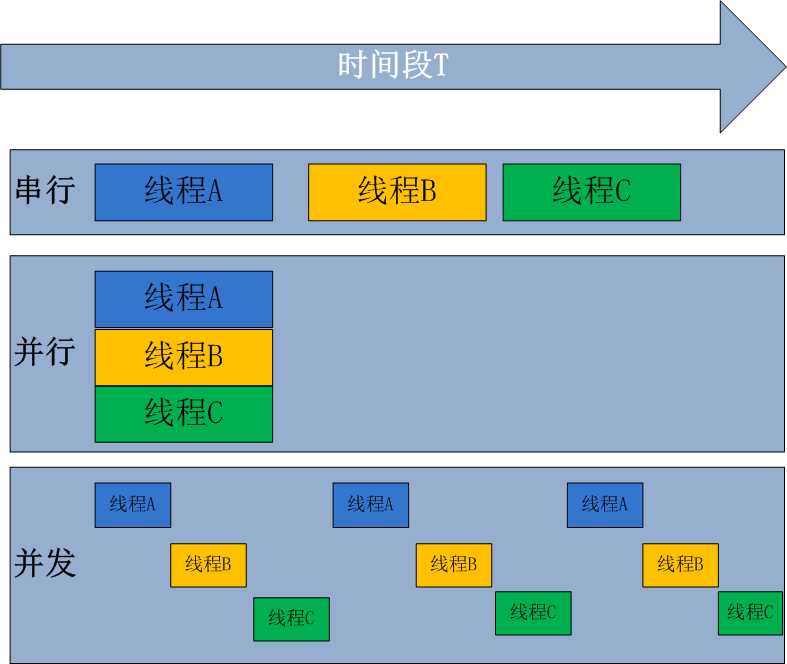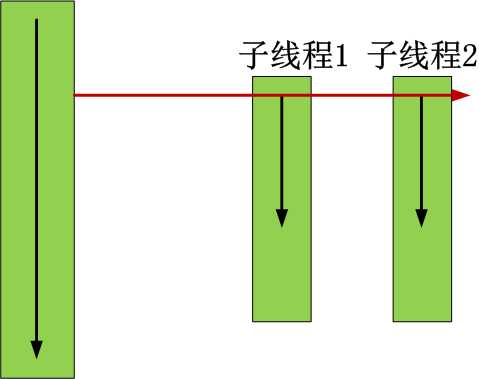标签:over ogr __init__ 管理 同步 other 恢复 logs tin
概念
进程:进程就是一个程序在一个数据集上的一次动态执行过程
程序:代码
数据集:程序执行过程中需要的资源
进程控制块:完成状态保存的单元
线程:线程是寄托在进程之上,为了提高系统的并发性
线程是进程的实体
进程是一个资源管理单元、线程是最小的执行单元
线程和进程的关系

(1)一个线程只能属于一个进程,而一个进程可以有多个线程,但至少有一个线程。
(2)资源分配给进程,同一进程的所有线程共享该进程的所有资源。
(3)CPU分给线程,即真正在CPU上运行的是线程。
进程/线程切换原则:切换的操作者,操作系统
1、时间片,任务的处理时间
2、遇到io操作,切换
例如socket, accept发了一次系统调用,然后就等待操作系统调用,操作系统进行监听
3、优先级切换

并发:在一个时间段里,能够执行多个程序的能力
切换:即任务状态的保存,状态的恢复,是并发的条件
注:为了共用数据集,线程进行切换,线程切换的开销远远小于进程切换的开销
并行:多个cpu,在同一时刻能够执行多个程序
同步:同步就是指一个进程在执行某个请求的时候,若该请求需要一段时间才能返回信息,那么这个进程将会一直等待下去,直到收到返回信息才继续执行下去
异步:异步是指进程不需要一直等下去,而是继续执行下面的操作,不管其他进程的状态。当有消息返回时系统会通知进程进行处理,这样可以提高执行的效率。
举个例子,打电话时就是同步通信,发短息时就是异步通信。
python的线程
python加锁:同一时间只有一个线程出来被执行,在一个进程下实现真正意义上的线程并行,把多核的优势给浪费了(后边会讲)
threading模块
Thread类直接创建
1 import threading
2 import time
3
4 def countNum(n): # 定义某个线程要运行的函数
5
6 print("running on number:%s" %n)
7
8 time.sleep(3)
9
10 if __name__ == ‘__main__‘:
11
12 t1 = threading.Thread(target=countNum,args=(23,)) #生成一个线程实例
13 t2 = threading.Thread(target=countNum,args=(34,))
14
15 t1.start() #启动线程
16 t2.start()
17
18 print("ending!")

#继承Thread式创建
import threading
import time
class MyThread(threading.Thread):
def __init__(self,num):
threading.Thread.__init__(self)
self.num=num
def run(self):
print("running on number:%s" %self.num)
time.sleep(3)
t1=MyThread(56)
t2=MyThread(78)
t1.start()
t2.start()
print("ending")
# join():在子线程完成运行之前,这个子线程的父线程将一直被阻塞。
# setDaemon(True):
‘‘‘
将线程声明为守护线程,必须在start() 方法调用之前设置,如果不设置为守护线程程序会被无限挂起。
当我们在程序运行中,执行一个主线程,如果主线程又创建一个子线程,主线程和子线程 就分兵两路,分别运行,那么当主线程完成
想退出时,会检验子线程是否完成。如果子线程未完成,则主线程会等待子线程完成后再退出。但是有时候我们需要的是只要主线程
完成了,不管子线程是否完成,都要和主线程一起退出,这时就可以 用setDaemon方法啦‘‘‘
import threading
from time import ctime,sleep
import time
def Music(name):
print ("Begin listening to {name}. {time}".format(name=name,time=ctime()))
sleep(3)
print("end listening {time}".format(time=ctime()))
def Blog(title):
print ("Begin recording the {title}. {time}".format(title=title,time=ctime()))
sleep(5)
print(‘end recording {time}‘.format(time=ctime()))
threads = []
t1 = threading.Thread(target=Music,args=(‘FILL ME‘,))
t2 = threading.Thread(target=Blog,args=(‘‘,))
threads.append(t1)
threads.append(t2)
if __name__ == ‘__main__‘:
#t2.setDaemon(True)
for t in threads:
#t.setDaemon(True) #注意:一定在start之前设置
t.start()
#t.join()
#t1.join()
#t2.join() # 考虑这三种join位置下的结果?
print ("all over %s" %ctime())
daemon A boolean value indicating whether this thread is a daemon thread (True) or not (False). This must be set before start() is called, otherwise RuntimeError is raised. Its initial value is inherited from the creating thread; the main thread is not a daemon thread and therefore all threads created in the main thread default to daemon = False. The entire Python program exits when no alive non-daemon threads are left. 当daemon被设置为True时,如果主线程退出,那么子线程也将跟着退出, 反之,子线程将继续运行,直到正常退出。
Thread实例对象的方法 # isAlive(): 返回线程是否活动的。 # getName(): 返回线程名。 # setName(): 设置线程名。 threading模块提供的一些方法: # threading.currentThread(): 返回当前的线程变量。 # threading.enumerate(): 返回一个包含正在运行的线程的list。正在运行指线程启动后、结束前,不包括启动前和终止后的线程。 # threading.activeCount(): 返回正在运行的线程数量,与len(threading.enumerate())有相同的结果。
IO密集型任务:程序中存在大量IO操作
计算密集型任务:程序中存在大量计算操作
对于python而言,处理io密集型任务有优势,对于计算密集型任务没优势
标签:over ogr __init__ 管理 同步 other 恢复 logs tin
原文地址:http://www.cnblogs.com/chenqizhou/p/7200929.html